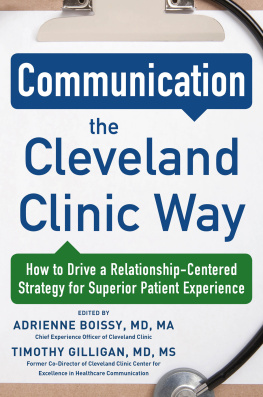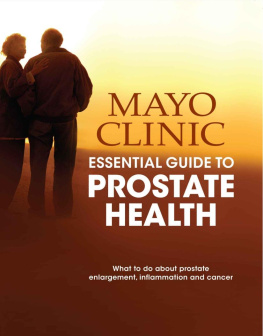Chapter 1
Group Practices Provide Betterand CheaperCare
Winter in Cleveland can be beautiful when the air is crisp and the evergreens are cloaked in white. But by mid-March, with its bare trees and gray skies, a longing for something more alive fills the air. Against this backdrop, Lisa Cant-well, a woman in her twenties, saw her doctor for a prenatal ultrasound. Already the mother of two young children, she had been through prenatal testing before. But nothing could have prepared her for the ordeal that she and her husband, Josh, were about to face.
The ultrasound, performed at 18 weeks, showed something in the babys necka dark mass, six centimeters across. In 35 years, Lisas prenatal specialist had never seen anything like it.
Several follow-up scans that spring and summer revealed that the cyst was growing. Lisas caregivers were concerned that the cyst would impair the babys ability to breathe. Her case was transferred from Cleveland Clinics community hospital to the main campus, which handles the most serious medical cases. Mother and child were admitted to the Fetal Care Center, where a multidisciplinary team of obstetricians, neonatologists, and pediatric subspecialists would provide care. The center is not a place but a virtual team linked by purpose, protocols, and electronic medical records.
When the time came for Lisa to give birth, Dr. Paul Krakowitz, a leading pediatric head and neck surgeon, discovered that the mass was just under the babys windpipe. The baby might not be able to breathe outside the uterus. Cutting the umbilical cord could prove fatal.
Dr. Krakowitzs team used a rare procedure. Two operating rooms were prepared side by side. Surgeons waited in the second room, ready to operate on the baby if needed. In the first room, Lisa had a normal cesarean, but the baby was lifted only partially out of the uterus. Before full birth, Dr. Krakowitz performed an endoscopy to see whether the babys windpipe was clear. It was. Baby Dominick was fully delivered and sent to the Neonatal Intensive Care Unit.
To the naked eye, the babys neck looked perfectly normal, but the cyst was under the skinand growing. It was a cystic hygroma, a large sac filled with fluid. Once they were home, Lisa carefully monitored Dominick to ensure that the cyst didnt impede his breathing. Almost every day, she checked in by phone with the nurse who ran the Fetal Care Center. But in the second week, Lisa noticed that Dominick was turning blue. The cyst had grown so big that it was strangling her son.
Lisa and Josh rushed Dominick to Cleveland Clinics Emergency Department. Doctors intubated Dominick to open his airway, and Dr. Krakowitz prepared to operate. The next day, he removed a cyst running from the left lobe of the thyroid into the cervical spine, up through the thyroid cartilage, and into one of the tubes that connect the nasal cavity to the ears. These structures are tiny in a two-week-old infant, and the cranial nerves that control hearing and speech run through them. Bleeding had to be controlled because babies dont have much blood to begin with. The operation, which took 4 hours, was a success. Dominick was moved to the Pediatric Intensive Care Unit, where additional medical specialists and highly trained nurses stabilized him. He was on the road to recovery and a normal life.
How Doctors Are Organized Matters
No single person saved Dominicks life. His survival lay in the hands of many caregivershighly skilled specialists who included radiologists, otolaryngologists, neonatologists, obstetricians, anesthesiologists, nurses, and technicians. The caregivers who treated Dominick were an integrated group, with each function supporting every other function. Every circuit was connected, from the top medical specialist to the nurses to the blue-scrubs team that disinfected the operating rooms. Like any tightly knit team in the corporate world, Dominicks caregivers all wore the same logo, reported up the same organizational chart, and had the same signature on their paychecks. They also had the same mission: to save lives, put patients first, and advance the cause of health and medicine. And as members of a group practice, they had the protection of quality and safety protocols, cost efficiencies in purchasing, and a commitment to innovation and process improvement.
For all the talk about Americas healthcare system, its not a system at all. There are about 800,000 doctors in the United States. This small-scale, cottage-industry approach can deliver finely crafted services, but the quality of those services is variable, and costs are typically high. Coordination, standardization, quality improvement, and all the other factors that today make high-quality products and services available to more people more rapidly and more cheaply than at any other time in history have yet to be generally implemented in healthcare.
However, the same strategies that have revolutionized every industry from textile manufacturing to farming over the past 250 years can be applied to healthcare. The first step is to organize doctors differentlyto bring them together to form much larger organizations led by doctors, not professional managers.
In 2005, only 4.5 percent of American doctors worked in group practices of 50 or more. But this is rapidly changing. More of American healthcare undoubtedly will shift to the group practice model embraced by the Mayo Clinic, the Cleveland Clinic, Kaiser Permanente (California), and similar organizations. We will probably see more and more groupings of hundreds, even thousands, of physicians. These groups invariably willand shouldembrace a corporate model, paying doctors a salary, tying continued employment and raises to annual performance reviews, and leveraging their size to buy high-quality equipment and supplies more cheaply.
Origins of the Group Practice Model and Cleveland Clinic
The group practice model was essentially born in the midwestern United States. The first nonprofit group practice was established by William and Charlie Mayo in Rochester, Minnesota, more than 100 years ago. Today, Mayo Clinic is the largest nonprofit group practice in the world. The second largest is Cleveland Clinic, founded in 1921. The founders of Cleveland ClinicGeorge Crile Sr., Frank Bunts, William Lower, and John Phillipswere good friends with the Mayo brothers. They hunted and fished together, stayed at one anothers homes, and shared ideas on the best way to organize the practice of medicine.
When Dr. Crile and his colleagues returned to Cleveland, they saw an opportunity to create an ideal medical center. They wanted to start with a blank slate and apply the lessons of the Mayo Clinic and military medicine to create a new kind of medical enterprise. Thus was born Cleveland Clinic.
Nonprofit
We are a nonprofit group practice. Nobody owns Cleveland Clinic. We are a community trust.
Board of Directors
At the top of the organization is an elected board of directors. The board oversees our nonprofit mission, approves budgets, sets compensation, and manages property transfers. The board includes business leaders, philanthropic leaders, and community-minded individuals.
CEO and President
Next is the CEO, who is also president of the board. The CEO sets policies in collaboration with an executive team and oversees the administration of all clinical and operational activities. The CEO communicates the organizations progress to caregivers, along with its mission, vision, and values.
Chief of Staff
The chief of staff manages all affairs relating to the employment of Cleveland Clinics medical staff.
Staff Physicians and Scientists








